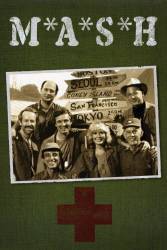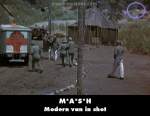Factual error: In the Swamp, Frank is complaining about everything, and goes to grab the still. The stove it's sitting on is a Coleman model 413E camping stove, a unit not seen until 1954, and the series takes place in 1950.
Factual error: When the camera looks at Lt. Clark, her rank insignia is horizontal. It should set from the apex (point) of the stitching diagonally (top end toward her face).
Baby, It's Cold Outside - S7-E9
Factual error: As Hawkeye performs CPR on the hypothermic soldier, he pumps his arms from his ellbows. CPR is done by keeping the arms stiff and pumping with the whole upper body. Hawkeye as a surgeon would know that. Fun Fact: You can perform CPR one-handed in a pinch, but only as long as you keep your arms stiff.
Factual error: When the South Korean Colonel and General are in the Mess Tent with BJ, their rank insignia is wrong. The insignia the Colonel is wearing is for a U.S. Colonel, and the General's insignia would not be three stars in a horizontal line.
Factual error: In the beginning, Hawkeye says that the patient was full of shrapnel from a claymore. M*A*S*H was set in the early 50's, and the M18 Claymore was only in the development stages in 1952, and not accepted and battle used until Vietnam in 1961.
Are You Now, Margaret? - S8-E2
Factual error: Then camera Klinger is using is not period correct. Those Brownie cameras were not around at that time.
Factual error: As Hawkeye, Radar' and BJ stop to change the flat, Hawkeye uses a scissor jack to raise the Jeep. However, the scissor jack was not in use for this model of Jeep.
Factual error: Radar claims in his report that Father Mulchahy tried to calm the prisoner by saying "bang zhao", thinking it means "peace and friendship" when it really means "your daughter's pregnancy brings much joy to our village." There is, unsurprisingly, not even a remotely similar word in Chinese that means either of those things.
Factual error: General Clayton is wearing ribbons on his regular fatigues. This is incorrect as the ribbons would only be displayed on the dress uniforms. Only the officer's rank would be on the fatigues.
Mad Dogs and Servicemen - S3-E13
Factual error: While Radar's lying in bed, Margaret reads a letter to him which was written by Wanda McCandless, and in the letter Wanda mentions that her favorite songs are "Pretty Thing..." by Bo Diddley, and "Oh, The Wayward Wind..." by Gogi Grant, but the problem is these songs were written and recorded in 1955 and 1956, years after the Korean War was already over in 1953.
Factual error: When Winchester is shown in the Post Op, his oak leaf and medical symbols are on the wrong lapels.
Hot Lips Is Back in Town - S7-E19
Factual error: In the beginning, you can see that there's a First Lieutenant bar on Margaret's left collar instead of the medical symbol Caduceus, like Charles has on.
Factual error: Radar finds a rabbi on board USS Essex, but the film shown of the Essex isn't...it's the USS Yorktown CV-10.
Factual error: The MP describes the antique vase Burns is supposed to have bought as "An 800-year-old seladon vase of the Ko-Yu dynasty". Later, Burns packs up a white vase to send to his wife. Seladon is by definition green, and that kind of color glazing definitely wasn't around in the 13th century. What Burns packs up looks most like early to middle Quing period - or rather a contemporary ripoff. (00:09:00 - 00:14:00)
Goodbye, Farewell, and Amen - S11-E16
Factual error: When Hawkeye leaves the tank after parking it in the trash heap, he comes out of the cupola hatch. He should be coming out of the driver's hatch, because he sure as hell didn't drive that tank from the turret.
Deal Me Out - S2-E13
Factual error: In this episode, Henry is seen handing Radar the keys to his jeep. While this probably benefited the understanding of the audience, it is historically incorrect. Jeeps assigned to a combat zone were outfitted with an ignition switch, not an ignition lock, for the simple reason that in an emergency the vehicle had to be useable by anyone. (00:03:40)
Factual error: The Chinese soldier holding the grenade in the operating theatre is speaking Japanese. (00:20:00 - 00:22:00)
Factual error: Nearly every show depicts the use of disposable plastic syringes, which weren't introduced till 1955, two years after the war ended.
Factual error: While eating, General Haggarty was told about how Conway should be a cook. Haggarty said "Change his (Conway's) MOS. MOS means Military Occupational Specialty, your job in service. Since M*A*S*H was set in the early 50's, Haggarty wouldn't have said that, because 'MOS' wasn't used until 1965.
Suggested correction: "MOS" most certainly was used during the Korean War. In 1965, the MOS system was simply changed, not created.
I perhaps misspoke. It was titled PMOS, and revamped in 1965 as just MOS. My apologies and thanks for the info.
According to "Introduction to Special Regulations SR 615-25-15, Enlisted Personnel Military Occupational Specialties" from the Department of the Army in November 1950, it's MOS. The "P" just means primary, but MOS was/is used way more than PMOS.
Factual error: In the Swamp, Dr. Wu says "maeu gamsahabnida" when taking out the needle. It was translated as "Dr. Wu says the treatment is completed." The correct translation is "thank you very much"
Suggested correction: This is taking the dialogue too literally. Translating culturally specific terms and forms of expression into something the counterpart can understand in the intended way is entirely appropriate and only logical. A person not familiar with English culture would be very confused if, for instance, someone translated the phrase "Your goose is cooked" literally.







Suggested correction: True, but doing CPR the real way is going to likely seriously injure the actor it is being performed upon.
LorgSkyegon
Explaining why mistakes occur does not invalidate them.
Bishop73
Chest compressions can definitely be performed by pumping from the elbow, one or two handed. The first documented use was in 1891, so Hawkeye would be aware of it. However, modern CPR standards, including straight arm procedures, were not developed until at least 1960 by the American Heart Association. Using straight arms and bending at the hips uses the larger muscle groups of the core and legs, which provides more control, as well as stamina. This is not an error for the Korean War era.
Additionally, what Lorg said - you don't want to hurt the actor, you can see his shoulders rise as his arms straighten, giving the illusion of compressions. There is another episode where Hawkeye is performing chest compressions similarly, and yells at the unconscious patient that his arms are getting tired, which is what would happen with bent elbow compressions, and one of the reasons modern technique uses straight arms.
I didn't know that, but it makes sense that CPR procedures would evolve. You should submit that as a direct correction to my mistake.
Doc ★